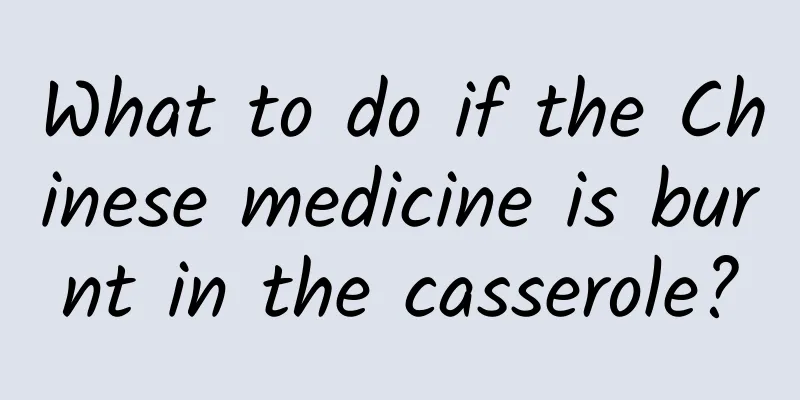What to do if the Chinese medicine is burnt in the casserole?

|
When cooking Chinese medicine, many people, in order to allow the medicinal properties of the medicine to fully penetrate into the soup, often cook it over high heat, then low heat, simmer it over low heat, and then simmer it over medium heat. Finally, they cook it for a long time before taking it down to drink. However, they find that it has been cooked into a paste. The medicinal effect of the cooked Chinese medicine has disappeared and it cannot be used. Otherwise, it is likely to cause some side effects. You must learn how to cook Chinese medicine correctly. Generally, decoctions are boiled over high heat and then simmered over low heat for about half an hour. However, antipyretic drugs, heat-clearing drugs, and aromatic drugs should not be boiled for a long time. Generally, they can be boiled for 15-20 minutes. The cooking time for tonic medicines is a little longer. Generally, after boiling over high heat, they should be simmered over low heat for 40-60 minutes. During this period, they should be stirred 2-3 times at intervals to prevent them from becoming mushy. Boil for about half an hour. Special attention should be paid when decocting herbs with high starch content and seed-based Chinese herbs rich in protein and mucus, because they are relatively easier to become mushy, such as: raw rehmannia, cooked rehmannia, yam, Scrophularia, Plantago, etc. The small particles should be wrapped in gauze and boiled. Special note: If Chinese herbal medicines are boiled into a mushy state, especially after being carbonized, their medicinal properties will change, and some may even produce substances that are harmful to the body. If you continue to take it, not only will it fail to achieve the desired therapeutic effect, but sometimes it may even be counterproductive. For example, Schizonepeta has the effects of dispelling exterior pathogens, dispersing wind, and clearing rashes. If it is boiled for too long, its active ingredients will evaporate. If it is boiled into a mushy state and becomes Schizonepeta charcoal, it will lose its effect of dispelling exterior pathogens and will only have the effect of stopping bleeding. For example, Puhuang is often used to promote blood circulation, but Puhuang charcoal after being boiled into a paste can stop bleeding, which is exactly the opposite effect. First of all, vessels such as casseroles or earthenware pots transfer heat slowly, conduct heat evenly, exert mild heat, have strong thermal insulation around the pot, are not prone to chemical changes and are inexpensive. When simmering for a long time over low heat, the water in the pot is not easy to evaporate, which can fully dissolve the active ingredients in the medicine. Secondly, some Chinese medicines, such as Rehmannia glutinosa (raw and cooked), Scrophularia ningpoensis, Gallnut, Sanguisorba officinalis, and White Peony Root, contain tannic acid. Tannic acid tastes astringent and can be dissolved in water. It is a medicine in itself and has excellent astringent effects. Therefore, tannic acid is often used as an "antidiarrheal agent" or "hemostatic agent." However, once tannic acid comes into contact with chemically active metals such as iron, copper, and aluminum, it is easy to form a water-insoluble film during the boiling process, that is, precipitates such as tannic acid iron and tannic acid copper are generated. In this way, tannic acid changes from a water-soluble component to a non-soluble component in water, and the human body cannot absorb it. In addition, Chinese medicines often contain alkaloids. The reason why traditional Chinese medicine can treat diseases is often because these alkaloids play various special physiological roles. For example, ephedrine can treat bronchitis; rauwolfia can treat high blood pressure, etc. These indispensable biological alkalis have a remarkable characteristic: most of them are insoluble in water. They can only be dissolved in water after chemically reacting with organic acids such as tannic acid to become salts. If a metal pot is used to decoct medicine, the loss of tannic acid will be too great, which will affect the dissolution of bioalkali and thus affect the efficacy of traditional Chinese medicine. Finally, metal pots are prone to produce some water-insoluble precipitates with other compounds in traditional Chinese medicine. The clay pot is made of silicate, which is very inactive chemically, thus effectively eliminating some problems existing in metal pots and better exerting the effect of traditional Chinese medicine. |
<<: Effects of Schisandra on the Liver
>>: Is tangerine peel the same as orange peel?
Recommend
The difference between cyperus rotundus and vinegar cyperus rotundus
Cyperus rotundus is a common Chinese medicine, an...
Who do you inherit your eyebrow shape from?
Eyebrows are an important part of people's im...
Chinese patent medicine for treating enlarged tongue and tooth marks
Some ancient books also discuss fat tongue togeth...
How to get rid of scars left by pimples
Acne is generally caused by clogged pores. In add...
What causes acne on the face
Acne vulgaris is actually what we often call acne...
Alzheimer's disease
Patients with Alzheimer's syndrome usually ex...
What are the effects and functions of mother of pearl?
In traditional Chinese medicine, many Chinese med...
The role of camphor leaves
Camphor tree leaves are oval in shape, and the su...
What to do if your child coughs in summer
The peak seasons for coughing are spring and wint...
What are the correct ways to wash your nose for rhinitis?
Rhinitis is a disease that causes great pain to p...
Symptoms of bacterial skin infections
Skin infections are quite common in our daily lif...
How many duck hearts can you eat in a day?
Duck heart is an important organ in the duck'...
Plasma colloid osmotic pressure
In our lives, we should learn more about some hea...
What are the symptoms of vestibular dysfunction?
Vestibular nerve dysfunction cannot be ignored. I...
What are the advantages and disadvantages of bamboo charcoal mask
Bamboo charcoal mask is different from traditiona...









